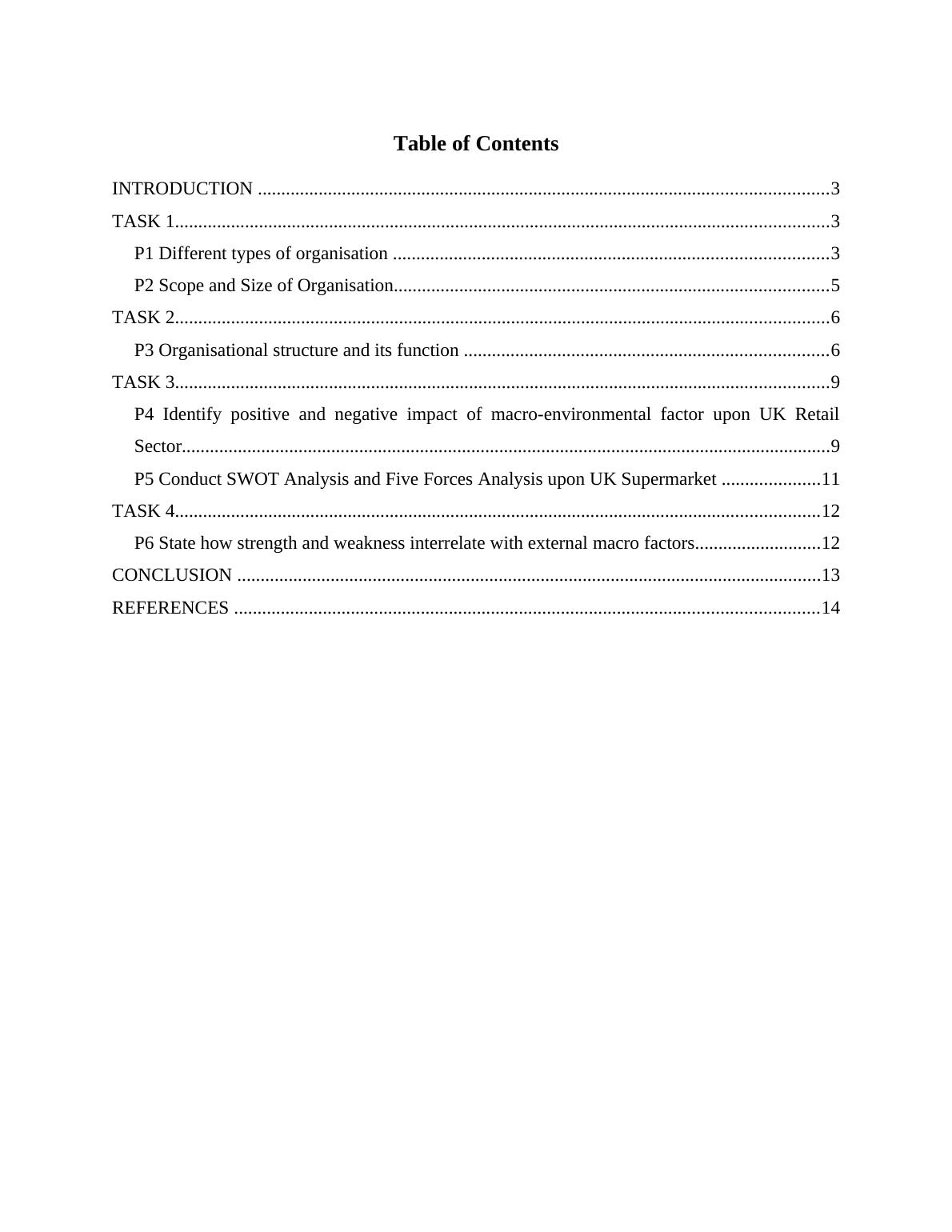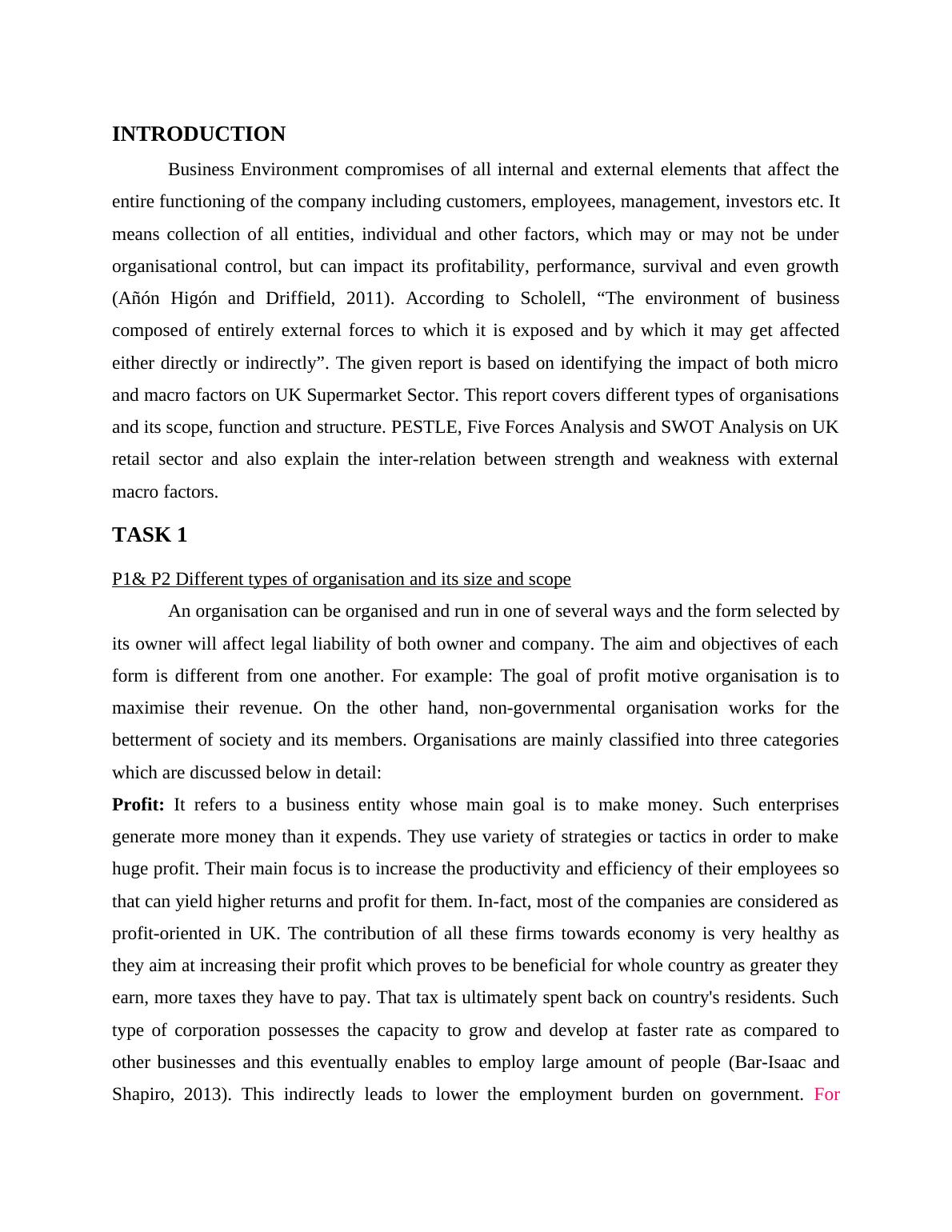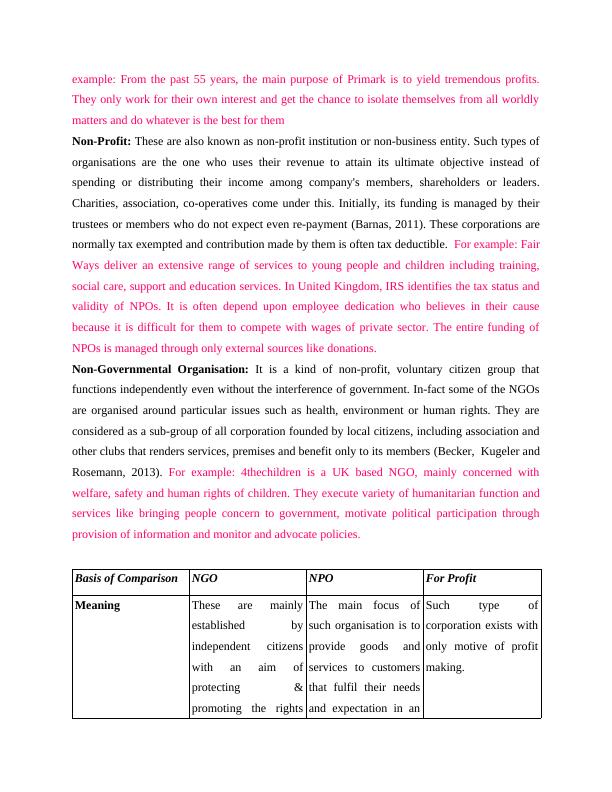Different Types of Organizational Structure
Added on 2020-06-06
14 Pages4319 Words47 Views
BUSINESSES AND
BUSINESS ENVIRONMENT
BUSINESS ENVIRONMENT

Table of Contents
INTRODUCTION ..........................................................................................................................3
TASK 1............................................................................................................................................3
P1 Different types of organisation .............................................................................................3
P2 Scope and Size of Organisation.............................................................................................5
TASK 2............................................................................................................................................6
P3 Organisational structure and its function ..............................................................................6
TASK 3............................................................................................................................................9
P4 Identify positive and negative impact of macro-environmental factor upon UK Retail
Sector...........................................................................................................................................9
P5 Conduct SWOT Analysis and Five Forces Analysis upon UK Supermarket .....................11
TASK 4..........................................................................................................................................12
P6 State how strength and weakness interrelate with external macro factors...........................12
CONCLUSION .............................................................................................................................13
REFERENCES .............................................................................................................................14
INTRODUCTION ..........................................................................................................................3
TASK 1............................................................................................................................................3
P1 Different types of organisation .............................................................................................3
P2 Scope and Size of Organisation.............................................................................................5
TASK 2............................................................................................................................................6
P3 Organisational structure and its function ..............................................................................6
TASK 3............................................................................................................................................9
P4 Identify positive and negative impact of macro-environmental factor upon UK Retail
Sector...........................................................................................................................................9
P5 Conduct SWOT Analysis and Five Forces Analysis upon UK Supermarket .....................11
TASK 4..........................................................................................................................................12
P6 State how strength and weakness interrelate with external macro factors...........................12
CONCLUSION .............................................................................................................................13
REFERENCES .............................................................................................................................14

INTRODUCTION
Business Environment compromises of all internal and external elements that affect the
entire functioning of the company including customers, employees, management, investors etc. It
means collection of all entities, individual and other factors, which may or may not be under
organisational control, but can impact its profitability, performance, survival and even growth
(Añón Higón and Driffield, 2011). According to Scholell, “The environment of business
composed of entirely external forces to which it is exposed and by which it may get affected
either directly or indirectly”. The given report is based on identifying the impact of both micro
and macro factors on UK Supermarket Sector. This report covers different types of organisations
and its scope, function and structure. PESTLE, Five Forces Analysis and SWOT Analysis on UK
retail sector and also explain the inter-relation between strength and weakness with external
macro factors.
TASK 1
P1& P2 Different types of organisation and its size and scope
An organisation can be organised and run in one of several ways and the form selected by
its owner will affect legal liability of both owner and company. The aim and objectives of each
form is different from one another. For example: The goal of profit motive organisation is to
maximise their revenue. On the other hand, non-governmental organisation works for the
betterment of society and its members. Organisations are mainly classified into three categories
which are discussed below in detail:
Profit: It refers to a business entity whose main goal is to make money. Such enterprises
generate more money than it expends. They use variety of strategies or tactics in order to make
huge profit. Their main focus is to increase the productivity and efficiency of their employees so
that can yield higher returns and profit for them. In-fact, most of the companies are considered as
profit-oriented in UK. The contribution of all these firms towards economy is very healthy as
they aim at increasing their profit which proves to be beneficial for whole country as greater they
earn, more taxes they have to pay. That tax is ultimately spent back on country's residents. Such
type of corporation possesses the capacity to grow and develop at faster rate as compared to
other businesses and this eventually enables to employ large amount of people (Bar-Isaac and
Shapiro, 2013). This indirectly leads to lower the employment burden on government. For
Business Environment compromises of all internal and external elements that affect the
entire functioning of the company including customers, employees, management, investors etc. It
means collection of all entities, individual and other factors, which may or may not be under
organisational control, but can impact its profitability, performance, survival and even growth
(Añón Higón and Driffield, 2011). According to Scholell, “The environment of business
composed of entirely external forces to which it is exposed and by which it may get affected
either directly or indirectly”. The given report is based on identifying the impact of both micro
and macro factors on UK Supermarket Sector. This report covers different types of organisations
and its scope, function and structure. PESTLE, Five Forces Analysis and SWOT Analysis on UK
retail sector and also explain the inter-relation between strength and weakness with external
macro factors.
TASK 1
P1& P2 Different types of organisation and its size and scope
An organisation can be organised and run in one of several ways and the form selected by
its owner will affect legal liability of both owner and company. The aim and objectives of each
form is different from one another. For example: The goal of profit motive organisation is to
maximise their revenue. On the other hand, non-governmental organisation works for the
betterment of society and its members. Organisations are mainly classified into three categories
which are discussed below in detail:
Profit: It refers to a business entity whose main goal is to make money. Such enterprises
generate more money than it expends. They use variety of strategies or tactics in order to make
huge profit. Their main focus is to increase the productivity and efficiency of their employees so
that can yield higher returns and profit for them. In-fact, most of the companies are considered as
profit-oriented in UK. The contribution of all these firms towards economy is very healthy as
they aim at increasing their profit which proves to be beneficial for whole country as greater they
earn, more taxes they have to pay. That tax is ultimately spent back on country's residents. Such
type of corporation possesses the capacity to grow and develop at faster rate as compared to
other businesses and this eventually enables to employ large amount of people (Bar-Isaac and
Shapiro, 2013). This indirectly leads to lower the employment burden on government. For

example: From the past 55 years, the main purpose of Primark is to yield tremendous profits.
They only work for their own interest and get the chance to isolate themselves from all worldly
matters and do whatever is the best for them
Non-Profit: These are also known as non-profit institution or non-business entity. Such types of
organisations are the one who uses their revenue to attain its ultimate objective instead of
spending or distributing their income among company's members, shareholders or leaders.
Charities, association, co-operatives come under this. Initially, its funding is managed by their
trustees or members who do not expect even re-payment (Barnas, 2011). These corporations are
normally tax exempted and contribution made by them is often tax deductible. For example: Fair
Ways deliver an extensive range of services to young people and children including training,
social care, support and education services. In United Kingdom, IRS identifies the tax status and
validity of NPOs. It is often depend upon employee dedication who believes in their cause
because it is difficult for them to compete with wages of private sector. The entire funding of
NPOs is managed through only external sources like donations.
Non-Governmental Organisation: It is a kind of non-profit, voluntary citizen group that
functions independently even without the interference of government. In-fact some of the NGOs
are organised around particular issues such as health, environment or human rights. They are
considered as a sub-group of all corporation founded by local citizens, including association and
other clubs that renders services, premises and benefit only to its members (Becker, Kugeler and
Rosemann, 2013). For example: 4thechildren is a UK based NGO, mainly concerned with
welfare, safety and human rights of children. They execute variety of humanitarian function and
services like bringing people concern to government, motivate political participation through
provision of information and monitor and advocate policies.
Basis of Comparison NGO NPO For Profit
Meaning These are mainly
established by
independent citizens
with an aim of
protecting &
promoting the rights
The main focus of
such organisation is to
provide goods and
services to customers
that fulfil their needs
and expectation in an
Such type of
corporation exists with
only motive of profit
making.
They only work for their own interest and get the chance to isolate themselves from all worldly
matters and do whatever is the best for them
Non-Profit: These are also known as non-profit institution or non-business entity. Such types of
organisations are the one who uses their revenue to attain its ultimate objective instead of
spending or distributing their income among company's members, shareholders or leaders.
Charities, association, co-operatives come under this. Initially, its funding is managed by their
trustees or members who do not expect even re-payment (Barnas, 2011). These corporations are
normally tax exempted and contribution made by them is often tax deductible. For example: Fair
Ways deliver an extensive range of services to young people and children including training,
social care, support and education services. In United Kingdom, IRS identifies the tax status and
validity of NPOs. It is often depend upon employee dedication who believes in their cause
because it is difficult for them to compete with wages of private sector. The entire funding of
NPOs is managed through only external sources like donations.
Non-Governmental Organisation: It is a kind of non-profit, voluntary citizen group that
functions independently even without the interference of government. In-fact some of the NGOs
are organised around particular issues such as health, environment or human rights. They are
considered as a sub-group of all corporation founded by local citizens, including association and
other clubs that renders services, premises and benefit only to its members (Becker, Kugeler and
Rosemann, 2013). For example: 4thechildren is a UK based NGO, mainly concerned with
welfare, safety and human rights of children. They execute variety of humanitarian function and
services like bringing people concern to government, motivate political participation through
provision of information and monitor and advocate policies.
Basis of Comparison NGO NPO For Profit
Meaning These are mainly
established by
independent citizens
with an aim of
protecting &
promoting the rights
The main focus of
such organisation is to
provide goods and
services to customers
that fulfil their needs
and expectation in an
Such type of
corporation exists with
only motive of profit
making.

End of preview
Want to access all the pages? Upload your documents or become a member.
Related Documents
Macro-environmental Factors on UK Supermarket Sector : Reportlg...
|26
|6411
|53
Business Environment of Tesco, Marks & Spencer : Assignmentlg...
|15
|4678
|102
Business and Business Environment: Sainsbury's Case Studylg...
|12
|4944
|94
Business and the Business Environmentlg...
|16
|4378
|22
Types of Organizations - Assignmentlg...
|14
|4134
|454
Business and Business Environment Assignment - ASDA organisationlg...
|14
|4005
|359
